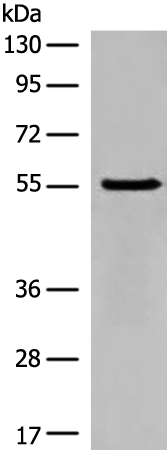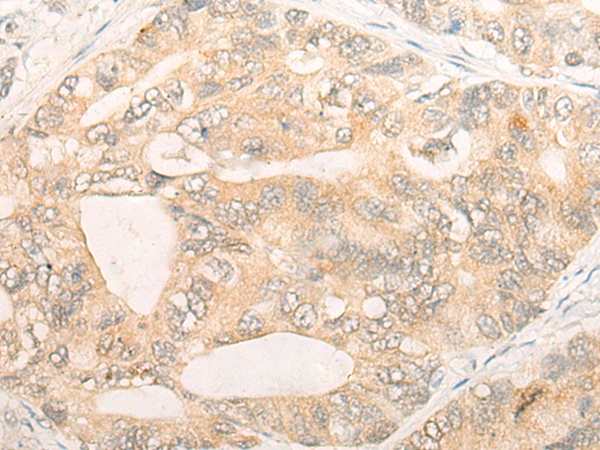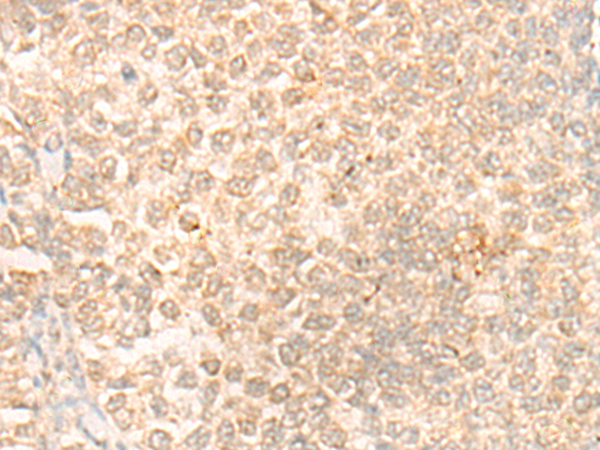


| WB | 咨询技术 | Human,Mouse,Rat |
| IF | 咨询技术 | Human,Mouse,Rat |
| IHC | 1/20-1/100 | Human,Mouse,Rat |
| ICC | 技术咨询 | Human,Mouse,Rat |
| FCM | 咨询技术 | Human,Mouse,Rat |
| Elisa | 1/5000-1/10000 | Human,Mouse,Rat |
| Aliases | IRT1; ARTD3; ADPRT3; ADPRTL2; ADPRTL3; PADPRT-3 |
| WB Predicted band size | 60 kDa |
| Host/Isotype | Rabbit IgG |
| Antibody Type | Primary antibody |
| Storage | Store at 4°C short term. Aliquot and store at -20°C long term. Avoid freeze/thaw cycles. |
| Species Reactivity | Human |
| Immunogen | Synthetic peptide of human PARP3 |
| Formulation | Purified antibody in PBS with 0.05% sodium azide and 50% glycerol. |
+ +
以下是3篇涉及PARP3抗体的参考文献,信息基于公开学术数据库的典型研究方向总结:
1. **"PARP3 is a promoter of chromosomal rearrangements and limits gene amplification"**
*Authors: R. M. Rulten et al.*
摘要:该研究使用特异性PARP3抗体验证PARP3在DNA损伤修复中的作用,发现PARP3通过调控染色体重组抑制基因扩增,抗体用于检测细胞中PARP3的定位及表达水平。
2. **"PARP3 controls ALK-mediated cell invasion in neuroblastoma"**
*Authors: S. S. M. Li et al.*
摘要:通过PARP3抗体进行免疫共沉淀和Western blot分析,揭示PARP3与ALK激酶相互作用促进神经母细胞瘤侵袭,抗体用于验证基因敲除模型的蛋白表达缺失。
3. **"Development and characterization of a novel PARP3-specific monoclonal antibody for functional studies"**
*Authors: J. E. Herter et al.*
摘要:文献报道了一种新型PARP3单克隆抗体的开发,通过免疫荧光和流式细胞术验证其特异性,并应用于研究PARP3在癌细胞DNA损伤应答中的动态变化。
*注:以上为领域典型研究方向示例,具体文献需通过PubMed/Google Scholar检索确认。近年研究多集中于PARP3在DNA修复、癌症靶向治疗及合成致死机制中的功能,抗体常被用于蛋白互作、定位及表达量检测。*
Poly(ADP-ribose) polymerase 3 (PARP3) is a member of the PARP enzyme family, which plays roles in DNA repair, genomic stability, and cellular stress responses. Unlike its well-characterized relatives PARP1 and PARP2. PARP3 exhibits distinct functional properties. It lacks the automodification domain critical for PARP1’s hyperactivation and shows preferential involvement in the repair of DNA double-strand breaks via non-homologous end joining (NHEJ). PARP3 also participates in mitotic progression, centromere integrity, and adaptation to oxidative stress, making it a multifaceted regulator of genome maintenance.
PARP3 antibodies are essential tools for studying its expression, localization, and molecular interactions. They enable detection of endogenous PARP3 in techniques like Western blotting, immunofluorescence, and immunoprecipitation. These antibodies are particularly valuable in cancer research, as PARP3 dysregulation has been linked to tumorigenesis, chemoresistance, and sensitivity to PARP inhibitors. Validated antibodies often target conserved regions, such as the catalytic domain or unique N-terminal motifs, to ensure specificity given the high homology among PARP family members. Challenges include distinguishing PARP3 from other PARPs due to structural similarities and low basal expression levels in some tissues. Recent studies using PARP3-knockout models or siRNA have improved antibody validation, clarifying its role in DNA damage responses and potential therapeutic targeting. Reliable PARP3 antibodies thus underpin advancing research into its biological mechanisms and clinical relevance.
×